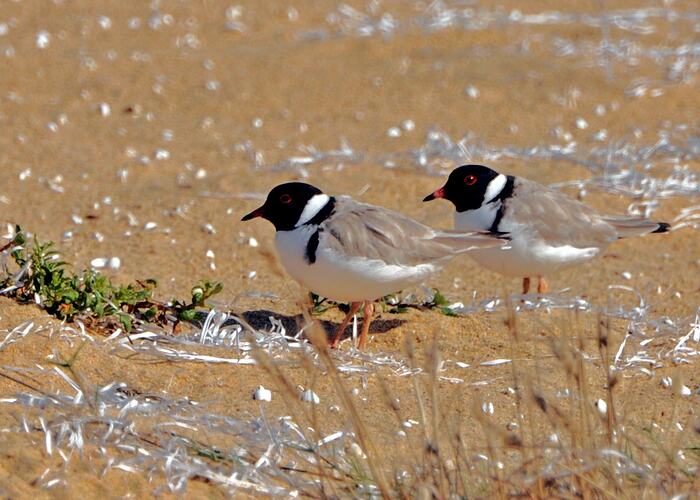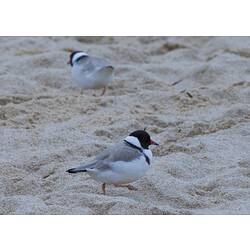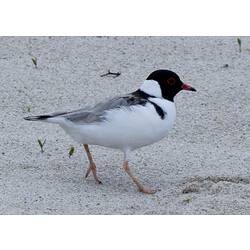General Description
A small, plump-looking shorebird with a black head and a wide white patch at the back of the neck (nape). The body is grey-brown above and white underneath. The bill is red with a black tip, and there is a red ring around the eye. The legs are pink. Bill to tail length is up to 23 cm. Hooded Plovers are usually seen on the beach in pairs or loose groups feeding along the edge of the water.
Biology
Hooded Plovers are beach-nesting birds. They lay their eggs on the sand above the high tide line, on sandy islands or in primary dune systems. They breed in spring and summer, and the normal clutch size is three eggs. The eggs are extremely well camouflaged and can accidentally be trodden on by people walking above the high tide line. The birds are easily disturbed by people, dogs, horses and vehicles on beaches during the breeding season and this often means that the eggs don't hatch or the chicks don't survive to adulthood. To help protect the nests and young, some beaches may have areas that are cordoned off while the birds are breeding, and beach users can help by keeping dogs on leads and staying outside fenced areas. Hooded Plovers feed on insects, crabs and small bivalve molluscs. There are two subspecies of Hooded Plover, both of which are threatened.
Distribution
Southern mainland Australia and Tasmania.
Habitat
Ocean sandy beaches and coastal lakes.
More Information
-
Animal Type
-
Animal SubType
-
Brief Id
A small beach-nesting shorebird with a black head, white neck, red bill and red eye ring. They run quickly along the beach, at times bobbing up and down in one spot.
-
Colours
Grey, White, Black
-
Maximum Size
23 cm
-
Habitats
-
Diet
Carnivore
-
Diet Categories
Molluscs, Crustaceans, Insects
-
Endemicity
-
Commercial
No
-
Conservation Statuses
CITES: Not listed, FFG Threatened List: Vulnerable, EPBC Act 1999: Vulnerable, IUCN Red List: Vulnerable
-
Taxon Name
-
Common Name
Hooded Plover
-
Other Names
Hooded Dotterel
-
Kingdom
-
Phylum
-
Subphylum
-
Class
-
Order
-
Family
-
Genus
-
Species Name
rubricollis




